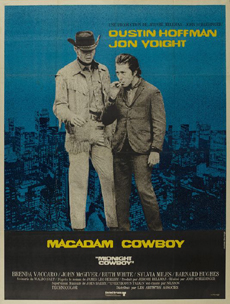The movie also won the Oscar for Best Director and for Best Writing,
Screenplay Based on Material from Another Medium (Waldo Salt).
At the beginning of the movie, we meet Joe Buck (Jon Voight), who is
in high spirits as he quits his thankless restaurant job in Texas and
makes ready to leave town. He tells a buddy his plan: in New York, he
says, the women are "begging for it" and willing to pay for
the privilege, and "most of the men are fruits." So he intends
to make his living as a gigolo.
We follow him on his long bus trip across the country, as he tries
to connect with his fellow passengers and listens to his transistor
radio. Of course, in New York he soon discovers that becoming a gigolo
isn't so easy, even for an attractive young man in a cowboy hat. He
meets an opportunist in a bar, Rico "Ratso" Rizzo, who promises
to help but then rips him off instead.
When Joe finally tracks down Ratso, he demands money, which Ratso doesn't
have. Then, realizing that Ratso is the only person he knows in town,
and having been kicked out of his apartment, he agrees to crash at Ratso's
run-down apartment. The two live moment-to-moment, resorting to petty
theft and other techniques to subsist, an existence that begins to tell
on both of them.
Much of the story is told visually: either through close-ups of people's
reactions to events, or through a series of flashbacks, which are snippets
of scenes from Joe's past. More of these scenes unravel as the movie
goes along, providing psychological insight into Joe and his troubled
past.
Certain scenes from this movie are very well known, such as an Andy
Warhol-style party, filled with artistes and hangers-on, with drug use,
snarky dialogue, and trippy music and visuals. The other well-known
scene is the final scene, which I won't spoil for those who haven't
seen it.
The secret power of this movie is that it becomes much more than viewers
initially expect. When we're first introduced to this naive yokel, we
know he's in for disappointment. Initially, his exploits seem somewhat
humorous. Before long, however, as his living situation gets worse and
his flashbacks intensify, he becomes a more complex, even tragic figure.
Voight plays this role convincingly, a role very different from the
tough, in-charge roles he typically plays today.
Hoffman is great as Ratso, whose wisecracks mask a deep insecurity
and who harbors his own painful past. He limps and is sensitive about
it. To play the role, Hoffman kept pebbles in his shoe to ensure the
limp would remain consistent. Reportedly, when he auditioned for the
film, Hoffman feared his all-American image could cost him the job,
so he told the auditioning film executive to meet him on a Manhattan
street corner. Hoffman got there ahead of time, dressed in rags, and
accosting people for change. Finally, he walked up to the exec and revealed
his true identity. For sure, watching this movie, there is little of
the Dustin Hoffman from The Graduate that contemporary viewers
knew and expected.
The movie was shot on location for exterior sequences, which adds to
the authenticity. The interior sets look convincing, as well: very much
like some of the older buildings in New York.
The minimal dialogue and visual style were ground breaking for the
time. Unlike many of the Oscar winners from the '60s, Midnight Cowboy
is a simple movie about two people. More than that, though, this movie
is about their internal story, what happens below the surface. These
characters' internal struggles are what gives the movie meaning and
makes it compelling to watch.


